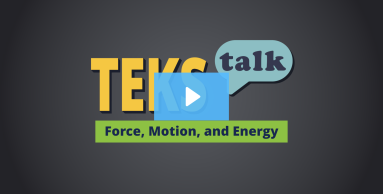
Knowledge and Skills Statement
The further explanation is designed to be a resource for educators that helps them better understand the topic their students are learning. Further explanations may be written at a more complex level than would be expected for students at the grade level.
Energy manifests in multiple phenomena, such as motion, light, sound, electrical and magnetic fields, and thermal energy. Energy can be modeled as either motion of particles or as stored in force fields (electric, magnetic, gravitational) that mediate interactions between particles. The total amount of energy in a system does not change, but it can be transferred between objects within the system. (Boundary: Energy transfer and transformations are taught in 5th grade.)
Research
Van Hook, Stephen J., and Tracy L. Huziak-Clark. 2008. “Lift, Squeeze, Stretch, and Twist: Research-based Inquiry Physics Experiences (RIPE) of Energy for Kindergartners.” Journal of Elementary Science Education 20, no. 3 (April 2008): 1–16. https://doi.org/10.1007/bf03174705.
Summary: There are several common misconceptions in young children's ideas about energy, which can lead to the misunderstanding of more complex energy concepts in upper-grade levels. It describes a study conducted in Kindergarten classes where students use hands-on activities to observe and describe how energy is used. Students were eventually able to articulate, in simple terms, that energy can be shifted to another object by lifting, squeezing, stretching, or twisting that object. Students also described some sources of energy for humans and animals and how they use energy.
